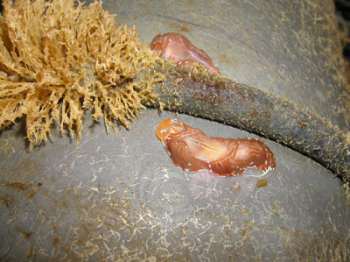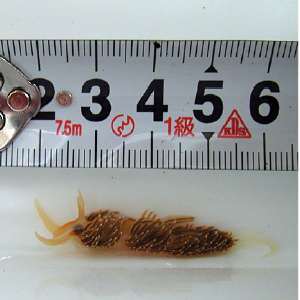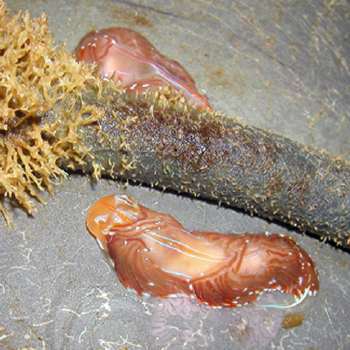Hermissenda - 1000 miles from land
November 15, 2003
From: Hiroaki Sakoh


Dear Bill,
I am a research scientist at the Mutsu Institute for Oceanography / Japan Marine Science and Technology Center. My speciality is primary production and low level food web in aquatic ecosystem. At present I am engaged in research of the carbon cycle of the northwest North Pacific. Moreover, my hobby is diving.
I would be grateful for some comments on this sea slug obsservation I have made.
I collected these animals slug from a mooring system moored in the northwestern North Pacific for one year. The mooring system was positioned at about 39N and 160E.
The depth of water of the place is about 5450m and the top depth of the mooring system was about 30m.
I collected four sea slugs from the top of an instrument moored at about 40m depth. It seems that these sea slugs are all of the same kind and I think they are probably Hermissenda crassicornis. Would you agree?
This mooring point is situated in the the Kurosiwo extension Current. However, the place is about a thousand nautical miles from the shore. I think that the adult sea slugs of this kind cannot swim long distances. If that is so I suspect the veliger larva were transported there by the Kuroshio Current. The speed of Kuroshio Current is 1-5 Knots. If the average speed of the current is 2 Knots, they would have taken at least 20 days to drift there.
Can they live as planktonic veliger larva for 20 days or more? I hear that Hermissenda crassicornis has a very large distribution from the Pacific coast in the United States to Japan. Did they settle down as they migrated from the west coast to the east coast of the Pacific Ocean? Is this an unusual observation? I woulod be grateful for your comments.
Sincerely yours,
Hiro
Hiroaki SAKOH
Mutsu Institute for Oceanography
Japan Marine Science and Technology Center
690 Kitasekine, Sekine,
Mutsu, Aomori, 035-0022 Japan
sakoh@jamstec.go.jp
Sakoh, H., 2003 (Nov 15) Hermissenda - 1000 miles from land. [Message in] Sea Slug Forum. Australian Museum, Sydney. Available from http://www.seaslugforum.net/find/11419
Dear Hiro,
Your animals are Hermissenda crassicornis, and as you suggest, they must have got to your mooring floats as larvae. If you have a look at the Hermissenda Fact Sheet, and in the attached messages, you will find quite a few references to the biology of this species.
The best place to look for information on larval biology, however, would be the Woods Hole Marine Biological Laboratory web site at: http://hermes.mbl.edu/BiologicalBulletin/MMER/KUZ/KuzTit.html
[Alan M. Kuzirian, Tom Capo, Donna McPhie, and Catherine T. Tamse. The sea slug, Hermissenda crassicornis: phylogeny, mariculture, and use as a model system for neurobiological research on learning and memory. [The Marine Biological Laboratory, Woods Hole, MA 02543]]
You will see there that the planktonic larvae have a mimimum 30 day planktonic stage before settlement. Settlement can be delayed until about 76 days but few can metamorphose successfully after 50 days. So if your calculation of a minimum travel time of 20 days is correct, then they certainly could travel the distance. Concerning your question about whether these may have stopped off on a migration from Japan to Nth America it's important to distinguish migration from geographic distribution. While birds and fish may undertake great distance migrations each year, the same cannot be said for small invertebrates. Present day distributions are most likely the result of slow incremental expansion from an initial origin. Perhaps now and then a few lucky larva may drift a long distance and make a quick expansion in geographic range but that would depend on more than one larva arriving at the same spot at the same time, finding an appropriate food source, settling together, and reaching reproductive maturity. This would involve a lot of luck.
Observations such as yours are rare, so I am very grateful you are willing to share it with us. Hopefully other contributors to the Forum will add further comments or similar observations
Best wishes
Bill Rudman
Related messages
-
Hermissenda crassicornis eating Flabellina trilineata
From: John Albers-Mead, August 15, 2007 -
Hermissenda vs. Corynactis
From: Bruce Wight, August 3, 2007 -
Nudibranch Parasite? - Hermissenda
From: Bruce Wight, August 1, 2007 -
Colour variation in Hermissenda crassicornis
From: Carissa Thomas, April 4, 2007 -
Hermissenda crassicornis from Oregon, USA
From: Julie Gilchrist, June 3, 2006 -
Re: Hermissenda crassicornis from Sth Korea
From: Ron Velarde, February 25, 2006 -
Hermissenda crassicornis from Sth Korea
From: Dong Bum Koh, February 24, 2006 -
Hermissenda crassicornis eating ascidians?
From: Marli Wakeling, February 3, 2006 -
Hermissenda crassicornis genetics
From: Martin H. Johnson, December 12, 2005 -
Re: Janolus fuscus from Puget Sound
From: Jeff Goddard, October 5, 2005 -
Re: Janolus fuscus from Puget Sound
From: Jack Connick, October 4, 2005 -
Re: Janolus fuscus from Puget Sound
From: Jack Connick, September 30, 2005 -
Flabellina pricei or mistaken identity
From: Jan Kocian, August 9, 2005 -
Re: Janolus fuscus from Puget Sound
From: Jeff Goddard, July 6, 2005 -
Re: Janolus fuscus from Puget Sound
From: Jack Connick, July 2, 2005 -
Re: Nudibranch eggs will travel
From: Marli Wakeling, May 9, 2005 -
Nudibranch eggs will travel
From: Marli Wakeling, May 7, 2005 -
Re: Raising Hermissenda for research
From: Ray Izumi, May 6, 2005 -
Raising Hermissenda for research
From: Daniel Swezey, April 29, 2005 -
Hermissenda crassicornis Cannibalism?
From: Daniel Swezey, February 28, 2005 -
Hermissenda crassicornis with eggs
From: Bruce Wight, February 10, 2005 -
Hermissenda crassicornis from California
From: Bruce Wight, August 9, 2004 -
Trailing behaviour in Hermissenda crassicornis
From: Marli Wakeling, December 22, 2003 -
Hermissenda crassicornis feeding
From: Glen Miller and Jackie Hildering, September 30, 2003 -
Hermissenda crassicornis without cerata
From: M.J. Adams, August 14, 2003 -
Hermissenda crassicornis from the Channel Ids, California
From: Bruce Wight, August 5, 2003 -
Hermissenda crassicornis from California
From: Chris Grossman, August 1, 2003 -
Re: Update on Hermissenda ailments
From: Rosemary Romero, July 30, 2003 -
Update on Hermissenda ailments
From: Ian Dow, July 18, 2003 -
Re: Ailments in Hermissenda crassicornis
From: Kathe R. Jensen, July 17, 2003 -
Ailments in Hermissenda crassicornis
From: Ian Dow, July 16, 2003 -
Hermissenda from California
From: Bruce Wight, October 17, 2002 -
Hermissenda crassicornis from British Columbia
From: Marli Wakeling, October 10, 2002 -
Hermissenda crassicornis from San Miguel, Calif.
From: Bruce Wight, August 12, 2002 -
Looking for photos of Hermissenda veligers
From: G. Sparks, July 22, 2001 -
Hermissenda crassicornis question
From: Robert Baker, June 12, 2001 -
Information on Hermissenda crassicornis
From: Bill Rudman, February 17, 2001 -
Variation in Hermissenda crassicornis
From: Bruce Wight, August 4, 2000 -
Hermissenda crassicornis feeding on Geoducks?
From: Pacific Shellfish Institute, August 4, 2000 -
Hermissenda crassicornis from California
From: Bruce Wight, July 15, 2000 -
Hermissenda Mating Preferences...
From: Ty Lim, March 6, 2000 -
Re: Hermissenda
From: Max O'Brien, February 20, 2000 -
Re: mating information
From: Ty Lim, February 16, 2000 -
Mating behaviour in Hermissenda
From: Ty Lim, February 15, 2000 -
Finding out what I see under water
From: Max O'Brien, February 7, 2000 -
Source for Hermissenda crassicornis on E. coast
From: David Chan, October 16, 1999 -
Re: Hermissenda feeding
From: Cesar Megina, July 22, 1999 -
Re: Hermissenda feeding
From: Benjamin Ross, July 21, 1999 -
What is the best food for Hermissenda?
From: Benjamin Ross, July 20, 1999 -
Re: Use of name Hermissenda
From: Bill Rudman, June 23, 1999 -
Correct genus for Hermissenda crassicornis
From: Maria Byrne, May 20, 1999
